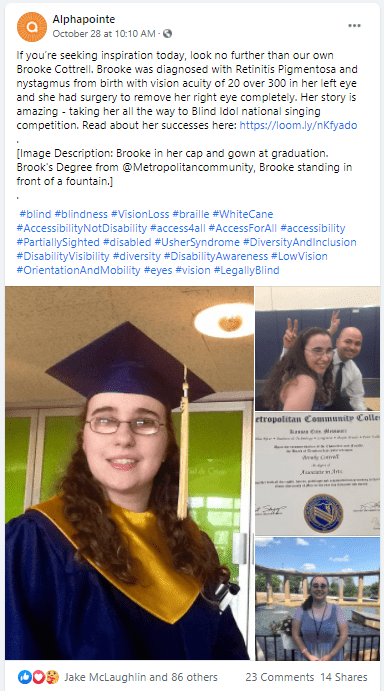
It’s easy to take for granted, for example, reading this article. Or hearing someone’s voice on the other end of the phone. Seeing a colleague or family member on Zoom. Walking to get the mail.
For many in PR, because of their day-to-day experiences, the thought of accessibility may not register when strategizing communication. But the truth is that 61 million Americans live with a disability, according to the Centers for Disease Control and Prevention. That's a sizable number to acknowledge when trying to release important information.
“As PR professionals, we often strive to have our messaging and materials reach as many people as possible,” says Rachel Carver, a senior specialist in PR at Outlook Business Solutions, which provides businesses with marketing, customer care and other services for professionals who are blind or visually impaired. “A common population that is overlooked is people with disabilities. That is a huge audience that remains largely untapped due to the lack of awareness and education about accessibility. PR professionals can do their clients and business a great service by ensuring materials can be accessed by a wide variety of people.”
Making PR Tools Accessible
For Carver, accessibility is not only a job, but a way of life, as we discovered in an article in PRNEWS. In PR for more than 10 years, Carver is the first blind person to receive PR accreditation. This allows Carver, and her company, to better understand accessibility needs. Many tools, including text to speech, braille, large-print, alt text, providing sign language at live press events and more, offer access for a larger audience.
“The good news is that it can be easy to start making your materials accessible,” Carver says. “There are accessibility tutorials, tools and checkers already built-in and available across many common software applications, such as Microsoft Word, Power Point and PDFs. A common feature of accessible documents and materials is alternative text (alt text) or a descriptive text for photos and images.”
Emma Bourke, CMO at Zodiac Guides, puts great effort into making her press releases accessible.
“Public relations professionals need to make a commitment to inclusion and social responsibility, in particular when it comes to press releases,” Bourke says.
Bourke’s list for an accessible press release includes:
- Have audio recordings for those with a visual impairment
- Provide captions on multimedia for those with a hearing impairment
- All images should have a clear description (alt text) of what the image is showing
- Use voiceovers in videos, and avoid music in the background
- Use clear and simple fonts in a reasonable size, and format for easy reading, using headings and bullets
- Always use inclusive language and avoid the charity narrative (for example, use people with disabilities instead of disabled people)
Digital Tools to Consider
Communication professionals should include a digital strategy when considering people with disabilities. Simon Thalman, digital marketing manager at Kellogg Community College, says, “accessibility concerns are a constant focus.”
“As an institution that receives federal funding, we’re actually required to do a lot of accessibility work that other organizations are not,” Thalman says. And this work comes is a great benefit to the community.
Thalman’s accessibility work in digital includes some of what Bourke referred to, but also includes:
- Using headers and styles in text documents (as opposed to merely bolding text, etc.)
- Linking to descriptive words and phrases as opposed to “click here,” etc.
“Accessibility is a moving target, particularly in regard to things like our websites and digital content, which is produced and/or updated daily by multiple stakeholders across the college, but we’re dedicated to continuous improvement,” he says. “The college makes use of an Accessibility Task Force, consisting of representatives from across college departments to monitor accessibility and move accessibility initiatives forward.”
In addition to an ADA-optimized website, it’s also important to consider other electronic communications, says Mike Vetti, director of communications at Alphapointe, a national nonprofit that provides employment to people who are blind/visually impaired as well as vision rehabilitation services.
“Regarding sending out information from an electronic standpoint, generally speaking, standard email works quite well because there have been rapid advancements in adaptive technology in recent years,” Vetti says. “There are terrific products such as JAWS and ZoomText that make it incredibly easy for people with vision loss to use/respond/create emails just as someone without vision impairment does on a daily basis.”
Vetti also provided a reminder not to forget about making social media posts accessible.
“Always making use of the native options for alt text is a good start, but depending on the software being used by people with vision loss, sometimes alt text is challenging to read/hear,” he says. “For now, a better solution is simply to type an image description into the post itself vs. relying solely on alt text. This works particularly well for platforms such as Facebook, Instagram and LinkedIn, where you’re not bound by character counts.”

Auditing Your Accessibility
With continual changes in accessibility guidelines and technology, it’s important to make sure your communication channels are updated and compliant.
One tool Thalman’s college utilizes to stay in compliance is Siteimprove. He said the resource regularly crawls the site to help track progress on remediating potential accessibility issues.
“All of these technologies—screen reading and accessibility software as much as our platforms and the content we produce—are in a pretty constant state of flux as they get regular updates and improvements,” Thalman says. “So you might fix something one day and have it need fixing again not long after, due to whatever system or requirement update is happening at any given time. And then you have all the different operating systems, browsers, mobile vs. desktop hardware from any number of providers to consider. So it’s a constant effort to be as in compliance as possible.”
Outlook Business Solutions is launching an accessibility test service, Carver said. It’s important to provide those needing accessible materials with a flawless service, she adds.
“Say you are building a web site or mobile application; we have a team that can determine if it’s usable by people who are blind, deaf or may have other physical impairments,” she says. “If people can’t access your site or digital materials, they are going to go somewhere else.”
Nicole Schuman is a reporter for PRNEWS. Follow her @buffalogal
